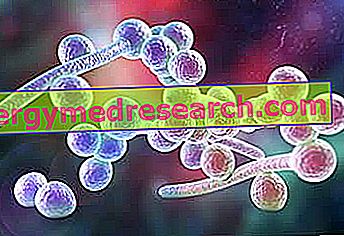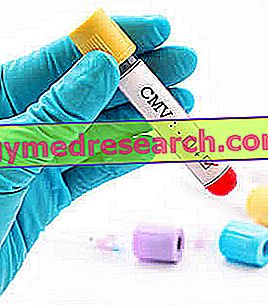Generality
Yeasts, from those with pathogenic to harmless properties, are eukaryotic microorganisms consisting of a single cell and belonging to the kingdom of fungi.

Under certain environmental conditions, many yeasts can become molds; this capacity is called dimorphism and the mushrooms that are its protagonists take on the name of dimorphic mushrooms.
There are numerous species of yeasts with pathogenic properties, ie with the ability to cause diseases (infections) in humans and other animals.
Among the main yeasts with pathogenic properties, include: Cryptococcus neoformans, Cryptococcus gattii, Pneumocystis carinii, Penicillium marneffei, Candida albicans and Histoplasma capsulatum .
Short reference to mushrooms
Fungi constitute a realm of eukaryotic living organisms, whose cells have some characteristics of animal cells (mitochondria, heterotrophy, etc.), some characteristics of plant cells (cell wall and vacuole) and some characteristics of bacterial cells (self-synthesis of 'amino acid L-lysine).
There are many types of fungi, from unicellular ones - that is, composed of only one cell - to multicellular ones - that is, made up of more than one cell; from those saprophytes to those parasites, from those edible to those pathogenic for the human being and not only etc.
Their history is very ancient; according to some studies, in fact, the first mushrooms would have been present on Earth already 3.5 billion years ago.
What are yeasts?
Yeasts are unicellular organisms - therefore microorganisms - belonging to the kingdom of fungi .
Appearing on the Earth several hundred million years ago, they represent about 1% of all currently known mushroom species.
In this article, the yeasts with the greatest attention are yeasts with pathogenic properties .
Yeasts with pathogenic properties are a particular category of fungi, capable of causing disease in human beings or in other living beings.
Other fungi with pathogenic properties are molds . Unlike yeasts, molds are multicellular organisms.
Table showing the scientific classification of yeasts | |
Domain: | eukaryotic |
Kingdom: | mushrooms |
Phylum and subphylum : | Ascomycetes ( Ascomycota )
Basidiomycetes ( Basidiomycota )
|
WHO ASSUMES THE STUDY OF PATOGENI YEASTS?
Pathogenic yeasts and, in general, all fungi capable of causing disease in humans (and not only), are the subject of study of the branch of medicine known as medical mycology .
Mycology is the term that indicates the biomedical discipline that studies fungi in general.
WHAT KIND OF DISEASES DO THE YEASTS CAUSE?
Diseases caused by pathogenic yeasts (and in general by all fungi with pathogenic properties) are infectious diseases or infections .
In specialized parlance, yeast infections and pathogenic fungi are generally called mycoses .
Fungal infections are many; to simplify the study, the doctors decided to classify them based on the site of infection. As a result, mycoses can be distinguished in 5 large groups (or types): superficial mycoses, cutaneous mycoses, subcutaneous mycoses (or subcutaneous mycoses ), systemic mycoses due to primary pathogens and systemic mycoses due to opportunistic pathogens .
The most famous pathogenic yeasts are usually responsible for systemic mycoses (of both types).
Biology
Being fungi, yeasts are eukaryotic organisms.
A eukaryotic organism is a living being whose cells possess:
- A specialized compartment, which takes the name of nucleus and which is the seat of DNA (or genetic material);
- A DNA organized in chromosomes ;
- A series of organelles and
- A complex system of intracellular phospholipid membranes .
In general, yeasts have a diameter of between 3 and 5 micrometers and a thick cell wall, consisting of: 60% glucans, 25% mannan, 10% protein / lipids and 5% chitin.
THEY ARE HETEROTROFI ORGANISMS
Yeasts and fungi in general are heterotrophic organisms.
A heterotrophic organism is a living being incapable of synthesizing the organic substances necessary for life, starting from inorganic substances; in order to survive, heterotrophic organisms must feed on organic substances produced by other organisms.
Living beings capable of synthesizing organic substances from inorganic substances are called autotrophic organisms . In nature, the autotrophic organisms par excellence are the plants, which produce organic substances starting from inorganic substances through the photosynthesis process.
REPRODUCTION
In the same way as non-pathogenic yeasts, yeasts with pathogenic properties are characterized by two modes of reproduction: the so-called binary splitting and the so-called budding .
Comparison with molds
Molds have the peculiarity of reproducing by sporogenesis, ie through the production of spores.
TYPICAL HABITAT
As the habitat most suited to their survival, pathogenic and non-pathogenic yeasts prefer damp environments, in which they can easily find sugars and amino acids.
Typical yeast habitats include: fruit surface, food in general and plant roots.
DO THE YEAS HAVE IFE?
Yeasts, from pathogens to non-pathogens, are the only fungi that do not give rise to the so-called hyphae (singular ifa ).
The hyphae are the filamentous structures that, in all fungi (except yeasts), form the so-called mycelium (or vegetative body ) and distinguish the fungal process known as vegetative growth .
YEASTS CAN ALSO BE MOLDED: THE DIMORPHISM IN MUSHROOMS
In particular environmental conditions or other circumstances, some species of yeast can become mold. Yeasts capable of turning into molds are organisms that from a single cell become multicellular and that acquire the ability to form hyphae, for the mycelium.
The ability of some fungi to be, on some occasions, yeasts and, on other occasions, molds is called dimorphism ; fungi that can be yeasts or molds, according to certain environmental conditions, are called dimorphic mushrooms .
Dimorphism is a capacity that affects numerous fungi with pathogenic properties.
In biology, the term dimorphism refers to the phenomenon in which an individual of the same living species is able to assume two different aspects or forms.
A dimorphic individual, therefore, is a subject that can present itself in two different forms.
clinic
Rarely, yeasts and pathogenic fungi in general infect healthy people. In fact, they usually attack individuals who:
- Suffer from diabetes . The high concentration of glucose in the blood ( hyperglycemia ), typical of diabetes, favors the proliferation of some particular fungi (including yeasts) that populate certain anatomical areas of the human body and that, under normal conditions (ie absence of diabetes) ), are completely harmless.
- They have undergone inadequate antibiotic therapies or for too long periods . Prolonged and / or inadequate intake of antibiotics destroys the gastrointestinal bacterial flora. The latter has the task of controlling the proliferation of fungi with pathogenic capacities, present physiologically within or in contact with the human organism. The impairment of the bacterial flora makes it easier to spread potentially pathogenic fungi, including yeasts, in the affected human being.
- They have an ineffective immune system . The immune system is an organism's defensive barrier against threats from the external environment, such as viruses, bacteria, fungi etc., but also from the internal environment, such as cancer cells (the so-called "mad cells") ) or malfunctioning.
To affect the efficiency of the human immune system may be morbid conditions, such as AIDS (ie HIV infection) or taking certain drugs, such as corticosteroids, chemotherapeutic drugs or immunosuppressants.
Moreover, it is good to remember that an inefficient immune system is typically present in very young subjects (NB: it is not yet fully developed) and in very elderly subjects (NB: it undergoes a physiological decrease in efficacy).
Examples
The most well-known yeasts with pathogenic capacities belong to the genus Cryptococcus - in this case Cryptococcus neoformans and Cryptococcus gattii - and to the genus Candida .
However, they also deserve a mention: the pathogenic yeast Pneumocystis carinii, belonging to the genus Pneumocystis ; the pathogenic yeast Penicillium marneffei, belonging to the genus Penicillium ; finally, the pathogenic yeasts Blastomyces dermatitidis, Coccidioides immitis, Coccidioides posadasii, Histoplasma capsulatum and Paracoccidioides brasiliensis .
All the aforementioned pathogenic yeasts are responsible for systemic mycoses, but:
- Cryptococcus neoformans, Cryptococcus gattii, Pneumocystis carinii, Penicillium marneffei and yeasts of the genus Candida are considered opportunistic pathogens (systemic mycoses due to opportunistic pathogens)
- the dimorphic yeasts Blastomyces dermatitidis, Histoplasma capsulatum, Paracoccidioides brasiliensis, Coccidioides immitis and Coccidioides posadasii are considered primary pathogens (systemic mycoses due to primary pathogens).
Cryptococcus neoformans and Cryptococcus gattii
They are yeasts responsible for a systemic mycosis which acts mainly in the lung and whose name corresponds to cryptococcosis .
The typical symptoms of cryptococcosis are: blurred vision, bone pain, chest pain, confusion, cough, fatigue, fever, headache, nausea, rash and profuse sweating.
Access routes to the human organism: respiratory tract, digestive system and vascular system.
Candida
yeasts of the genus Candida can cause a severe systemic mycosis, known as systemic candidiasis (or systemic candidiasis ). In reality, these yeasts are capable of causing a much less severe mycosis than systemic candidiasis, known as cutaneous candidiasis (a type of cutaneous mycosis).
There are many species of pathogenic yeasts belonging to the genus Candida ; the most important species include: Candida albicans, C. tropicalis, C. stellatoidea, C. glabrata, C. krusei, C. parapsilosis and C. lusitaniae .
Systemic Candida infections are very common among AIDS patients.
Access routes to the human body: respiratory tract, digestive system and vascular system. They are the three typical access routes of pathogens that induce the so-called systemic mycoses due to opportunistic pathogens.
Pneumocystis carinii
It is the yeast responsible for a systemic mycosis called pneumocystosis . Because of symptoms similar to those of pneumonia, pneumocystosis is common and can be highly lethal among those with reduced immune defenses, such as AIDS patients.
Access routes to the human body: respiratory tract, digestive system and vascular system.
Penicillium marneffei
It is a dimorphic fungus, which causes a systemic mycosis known as penicilliosis . Very frequent among AIDS patients, the systemic mycoses induced by Penicillium marneffei generally cause: fever, anemia, weight loss, skin lesions similar to papules, generalized lymphadenopathy and hepatomegaly.
Access routes to the human body: respiratory tract, digestive system and vascular system.
Blastomyces dermatitidis
It is a dimorphic fungus that causes a systemic mycosis called blastomycosis . Blastomycosis is characterized by a symptomatology that resembles that of pneumonia (difficulty breathing, cough, chest pain, etc.), fever, hot flushes, joint pain, myalgia, headache, skin rash, weight loss, etc.
Access routes to the human body: respiratory tract. It is the typical access pathway of pathogens that induce the so-called systemic mycoses due to primary pathogens.
Histoplasma capsulatum
is a dimorphic fungus that causes a systemic mycosis known as histoplasmosis . Widespread above all among people with reduced immune defenses (AIDS patients etc.), histoplasmosis is particularly characterized by symptoms in the lung.
Access routes to the human body: respiratory tract.
Paracoccidioides brasiliensis
It is a dimorphic fungus responsible for a systemic mycosis which is called paracoccidioidomycosis (or South American blastomycosis ).
Paracoccidioidomycosis involves various organs and tissues of the body, including the lungs (most affected organs), arteries, spleen, bones and meninges.
The most common symptoms are fever, cough and weight loss.
Access routes to the human body: respiratory tract.
Coccidioides immitis and Coccidioides posadasii
They are two dimorphic fungi responsible for a systemic mycosis called coccidioidomycosis (or valley fever ).
In most cases, coccidioidomycosis causes the characteristic symptoms of pneumonia, therefore: cough, respiratory problems, excessive mucus production, chest pain, fever, etc. Moreover, in some patients, it induces the appearance of: arthritis, conjunctivitis, erythema nodosum and / or erythema multiforme.
The subjects most affected are above all those who have an inefficient immune system.
Access routes to the human body, for both these yeasts / molds: respiratory tract.



